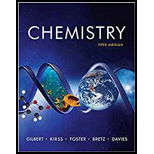
(a)
Interpretation: The number of orbitals in an atom with the given combinations of quantum number are to be stated.
Concept introduction: There are four quantum numbers that indicates the size, energy and shape of an atomic orbital. The quantum number
To determine: The number of orbitals in an atom for the given combination of quantum numbers.
(b)
Interpretation: The number of orbitals in an atom with the given combinations of quantum number are to be stated.
Concept introduction: There are four quantum numbers that indicates the size, energy and shape of an atomic orbital. The quantum number
To determine: The number of orbitals in an atom for the given combination of quantum numbers.
(c)
Interpretation: The number of orbitals in an atom with the given combinations of quantum number are to be stated.
Concept introduction: There are four quantum numbers that indicates the size, energy and shape of an atomic orbital. The quantum number
To determine: The number of orbitals in an atom for the given combination of quantum numbers.
Want to see the full answer?
Check out a sample textbook solution
Chapter 7 Solutions
CHEMISTRY:SCI.IN CONTEXT (CL)-PACKAGE
 ChemistryChemistryISBN:9781305957404Author:Steven S. Zumdahl, Susan A. Zumdahl, Donald J. DeCostePublisher:Cengage Learning
ChemistryChemistryISBN:9781305957404Author:Steven S. Zumdahl, Susan A. Zumdahl, Donald J. DeCostePublisher:Cengage Learning ChemistryChemistryISBN:9781259911156Author:Raymond Chang Dr., Jason Overby ProfessorPublisher:McGraw-Hill Education
ChemistryChemistryISBN:9781259911156Author:Raymond Chang Dr., Jason Overby ProfessorPublisher:McGraw-Hill Education Principles of Instrumental AnalysisChemistryISBN:9781305577213Author:Douglas A. Skoog, F. James Holler, Stanley R. CrouchPublisher:Cengage Learning
Principles of Instrumental AnalysisChemistryISBN:9781305577213Author:Douglas A. Skoog, F. James Holler, Stanley R. CrouchPublisher:Cengage Learning Organic ChemistryChemistryISBN:9780078021558Author:Janice Gorzynski Smith Dr.Publisher:McGraw-Hill Education
Organic ChemistryChemistryISBN:9780078021558Author:Janice Gorzynski Smith Dr.Publisher:McGraw-Hill Education Chemistry: Principles and ReactionsChemistryISBN:9781305079373Author:William L. Masterton, Cecile N. HurleyPublisher:Cengage Learning
Chemistry: Principles and ReactionsChemistryISBN:9781305079373Author:William L. Masterton, Cecile N. HurleyPublisher:Cengage Learning Elementary Principles of Chemical Processes, Bind...ChemistryISBN:9781118431221Author:Richard M. Felder, Ronald W. Rousseau, Lisa G. BullardPublisher:WILEY
Elementary Principles of Chemical Processes, Bind...ChemistryISBN:9781118431221Author:Richard M. Felder, Ronald W. Rousseau, Lisa G. BullardPublisher:WILEY





